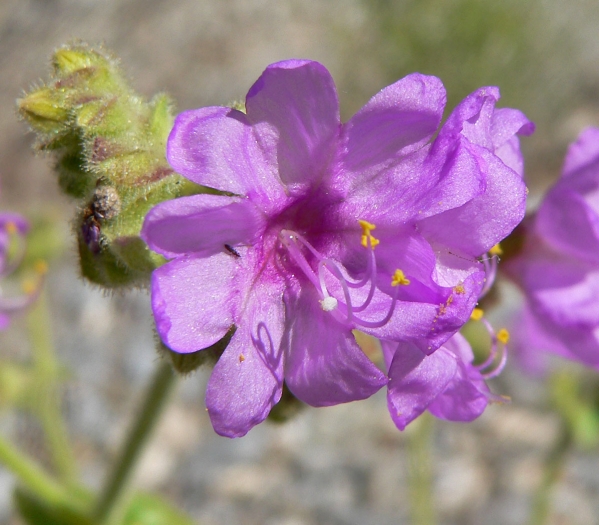White Four O’Clock
(Mirabilis albida)
White Four O’Clock (Mirabilis albida)
/
/

Stan Shebs
CC BY-SA 3.0
Image By:
Stan Shebs
Recorded By:
Copyright:
CC BY-SA 3.0
Copyright Notice:
Photo by: Stan Shebs | License Type: CC BY-SA 3.0 | License URL: http://creativecommons.org/publicdomain/zero/1.0/deed.en | Uploader: Stan Shebs | Publisher: Wikimedia Commons |



















































Estimated Native Range
Summary
Mirabilis albida, commonly known as White Four O’Clock, is a deciduous perennial herb or subshrub native to open woodlands, grasslands, and prairies in North America, particularly the Central United States, Mexico, and Canada. It typically grows to a height of 1-3 feet (0.3-0.9 meters) and a width of 1 foot (0.3 meters). The plant is known for its trumpet-shaped flowers that come in a variety of colors including white, which is most common, as well as red, pink, and purple. These blooms are most notable for their habit of opening in the late afternoon and closing by morning, hence the name "Four O’Clock." Flowering occurs in the summer and fall, and the flowers are quite showy, attracting pollinators such as hummingbirds and butterflies.
White Four O’Clock is valued for its low maintenance and drought tolerance once established, making it a suitable choice for xeriscaping. It is often used in borders, rock gardens, and as a ground cover. This plant prefers full sun but can tolerate part shade, and it thrives in well-drained soils. While generally pest-free, it can be susceptible to spider mites and powdery mildew in humid conditions. It is important to note that all parts of the plant are toxic if ingested.CC BY-SA 4.0
White Four O’Clock is valued for its low maintenance and drought tolerance once established, making it a suitable choice for xeriscaping. It is often used in borders, rock gardens, and as a ground cover. This plant prefers full sun but can tolerate part shade, and it thrives in well-drained soils. While generally pest-free, it can be susceptible to spider mites and powdery mildew in humid conditions. It is important to note that all parts of the plant are toxic if ingested.CC BY-SA 4.0
Plant Description
- Plant Type: Herb, Subshrub
- Height: 1-3 feet
- Width: 0.333-1 feet
- Growth Rate: Moderate
- Flower Color: White
- Flowering Season: Summer, Fall
- Leaf Retention: Deciduous
Growth Requirements
- Sun: Full Sun
- Water: Medium
- Drainage: Fast
Common Uses
Bee Garden, Bird Garden, Butterfly Garden, Deer Resistant, Hummingbird Garden, Low Maintenance, Rabbit Resistant, Rock Garden
Natural Habitat
Open woodlands, grasslands, and prairies
Other Names
Common Names: Mountain Four-O’Clock, White Four-O’Clock, Hairy Four-O’Clock, Hairy Umbrellawort, Pale Four-O’Clock, Pale Umbrellawort, Nyctage Hirsute
Scientific Names: , Mirabilis albida, Mirabilis oblongifolia, Oxybaphus hirsutus, Mirabilis dumetorum, Mirabilis grayana, Mirabilis pseudaggregata, Oxybaphus albidus, Mirabilis coahuilensis, Mirabilis lanceolata
GBIF Accepted Name: Mirabilis albida (Walter) Heimerl